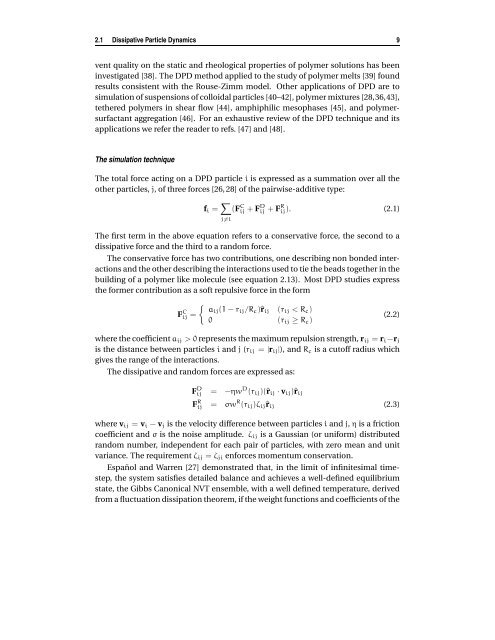Mesoscopic models of lipid bilayers and bilayers with embedded ...
Mesoscopic models of lipid bilayers and bilayers with embedded ...
Mesoscopic models of lipid bilayers and bilayers with embedded ...
Create successful ePaper yourself
Turn your PDF publications into a flip-book with our unique Google optimized e-Paper software.
2.1 Dissipative Particle Dynamics 9<br />
vent quality on the static <strong>and</strong> rheological properties <strong>of</strong> polymer solutions has been<br />
investigated [38]. The DPD method applied to the study <strong>of</strong> polymer melts [39] found<br />
results consistent <strong>with</strong> the Rouse-Zimm model. Other applications <strong>of</strong> DPD are to<br />
simulation <strong>of</strong> suspensions <strong>of</strong> colloidal particles [40–42], polymer mixtures [28,36,43],<br />
tethered polymers in shear flow [44], amphiphilic mesophases [45], <strong>and</strong> polymersurfactant<br />
aggregation [46]. For an exhaustive review <strong>of</strong> the DPD technique <strong>and</strong> its<br />
applications we refer the reader to refs. [47] <strong>and</strong> [48].<br />
The simulation technique<br />
The total force acting on a DPD particle i is expressed as a summation over all the<br />
other particles, j, <strong>of</strong> three forces [26, 28] <strong>of</strong> the pairwise-additive type:<br />
fi = <br />
(F C ij + F D ij + F R ij). (2.1)<br />
j=i<br />
The first term in the above equation refers to a conservative force, the second to a<br />
dissipative force <strong>and</strong> the third to a r<strong>and</strong>om force.<br />
The conservative force has two contributions, one describing non bonded interactions<br />
<strong>and</strong> the other describing the interactions used to tie the beads together in the<br />
building <strong>of</strong> a polymer like molecule (see equation 2.13). Most DPD studies express<br />
the former contribution as a s<strong>of</strong>t repulsive force in the form<br />
F C ij =<br />
aij(1 − rij/Rc)^rij (rij < Rc)<br />
0 (rij ≥ Rc)<br />
(2.2)<br />
where the coefficient aij > 0 represents the maximum repulsion strength, rij = ri−rj<br />
is the distance between particles i <strong>and</strong> j (rij = |rij|), <strong>and</strong> Rc is a cut<strong>of</strong>f radius which<br />
gives the range <strong>of</strong> the interactions.<br />
The dissipative <strong>and</strong> r<strong>and</strong>om forces are expressed as:<br />
F D ij = −ηw D (rij)(^rij · vij)^rij<br />
F R ij = σw R (rij)ζij^rij (2.3)<br />
where vij = vi − vj is the velocity difference between particles i <strong>and</strong> j, η is a friction<br />
coefficient <strong>and</strong> σ is the noise amplitude. ζij is a Gaussian (or uniform) distributed<br />
r<strong>and</strong>om number, independent for each pair <strong>of</strong> particles, <strong>with</strong> zero mean <strong>and</strong> unit<br />
variance. The requirement ζij = ζji enforces momentum conservation.<br />
Español <strong>and</strong> Warren [27] demonstrated that, in the limit <strong>of</strong> infinitesimal timestep,<br />
the system satisfies detailed balance <strong>and</strong> achieves a well-defined equilibrium<br />
state, the Gibbs Canonical NVT ensemble, <strong>with</strong> a well defined temperature, derived<br />
from a fluctuation dissipation theorem, if the weight functions <strong>and</strong> coefficients <strong>of</strong> the

















